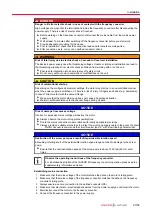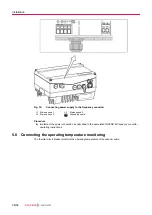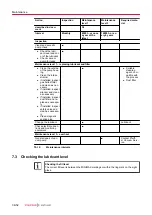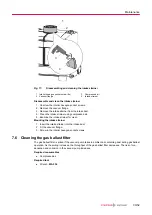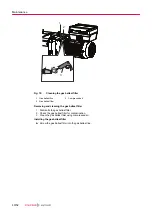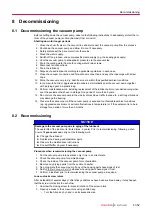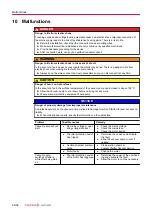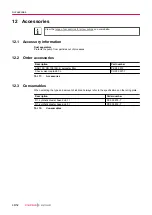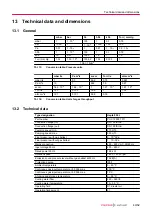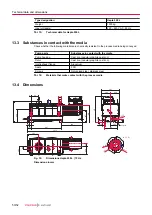
8 Decommissioning
8.1 Decommissioning the vacuum pump
Before shutting down the vacuum pump, observe the following instructions to adequately protect the in-
terior of the vacuum pump (suction chamber) from corrosion:
Shutting down for longer periods
1. Close the shut-off valve in the vacuum line and disconnect the vacuum pump from the process.
2. Shut down the vacuum pump and allow it to cool if necessary.
3. Safely disconnect the drive motor from the mains.
4. Close the water supply.
5. Switch off the process- and pump-specific media supply (e.g. the sealing gas supply).
6. Vent the vacuum pump to atmospheric pressure via the vacuum side.
7. Drain the cooling water from both cooling water drain screws.
8. Disconnect all connections.
9. Drain the lubricant.
10. Dispose of used lubricant according to applicable regulations in each case.
11. Close the vacuum connection and fore-vacuum connection and any other openings with screw
caps.
12. Store the vacuum pump in dry, dust-free rooms, within the specified ambient conditions.
13. In rooms with humid or aggressive atmospheres: Hermetically seal the vacuum pump together
with a drying agent in a plastic bag.
14. Perform maintenance work, including replacement of the lubricant prior to recommissioning wher-
ever the equipment has been in storage for a period of more than 2 years.
15. Do not store the vacuum pump in the vicinity of machines, traffic routes, etc., as strong vibrations
may damage the bearing.
16. Preserve the vacuum pump if the vacuum pump is exposed to unfavorable ambient conditions
(e.g. aggressive environment, extreme fluctuations in temperature) or if the equipment is to be in
storage for a period of more than 3 months.
8.2 Recommissioning
NOTICE
Damage to the vacuum pump due to aging of the lubricant
The useful life of the lubricant is limited (max. 2 years). Prior to recommissioning, following a shut-
down of
2 years or more
, carry out the following work.
► Change the lubricant.
► Replace the bearing and elastomer parts.
► Observe the maintenance instructions.
► Consult Pfeiffer Vacuum if necessary.
Procedure when recommissioning the vacuum pump
1. Put the vacuum pump into operation only if it is in a correct state.
2. Check the vacuum pump for visible damage.
3. Check the inside of the vacuum pump for contamination.
4. Remove any drying pearls from the suction chamber.
5. Do not operate the vacuum pump if any of the housing parts have signs of rust.
6. Notify
whenever housing parts have signs of rust.
7. Perform a leak test prior to recommissioning the vacuum pump as required.
Loosen stuck screw rotors
After a standstill of several days or after sticky substances have been suctioned away, it may happen
that the screw rotors stick to each other.
1. Unscrew the closing screw for manual rotation of the screw rotors.
2. Open up access to the screw rotors using an Allen key.
– Turn the Allen key by hand in a clockwise direction.
Decommissioning
41/52

